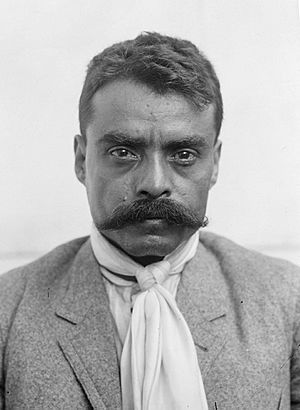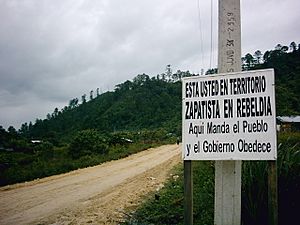Emiliano Zapata facts for kids
Quick facts for kids
Emiliano Zapata
|
|
|---|---|

Zapata in 1914
|
|
| Nickname(s) | El Caudillo del Sur, Attila of the South, and "E" |
| Born | August 8, 1879 Anenecuilco, Morelos, Mexico |
| Died | 10 April 1919 (aged 39) Chicameca, Morelos, Mexico |
| Allegiance | Mexico (Zapatismo revolutionary forces) |
| Years of service | 1910–1919 |
| Rank | General |
| Commands held | Liberation Army of the South |
| Battles/wars | Mexican Revolution |
| Signature |  |
Emiliano Zapata Salazar (August 8, 1879 – April 10, 1919) was a very important Mexican revolutionary. He was a key leader in the Mexican Revolution (1910–1920). Zapata led a people's revolution in the Mexican state of Morelos. He also inspired a farming movement called Zapatismo.
Contents
Emiliano Zapata's Early Life
Zapata was born in a small village called Anenecuilco in Morelos. His parents were Gabriel Zapata and Cleofas Jertrudiz Salazar. Emiliano was the ninth of ten children. His family was well-known and had some money.
Emiliano's father was a farmer and trained horses. Growing up on a farm, Emiliano learned about the tough life in the countryside. He saw how his village struggled to get back land taken by large farms called haciendas. He went to school for a short time and learned basic math. When Emiliano was about 16 or 17, his father died. Emiliano then had to take care of his family.
He was good at business. He bought mules to carry corn from farms to town. He also moved bricks to a large farm nearby. Emiliano was a successful farmer, growing watermelons to sell. He was also a very skilled horseman. He competed in rodeos and races. He even fought bulls while riding a horse. Because he was so good with horses, he got a job training horses for Ignacio de la Torre y Mier. Ignacio was the son-in-law of Mexico's president, Porfirio Díaz.
Zapata's Fight for Justice
During Zapata's time, poor farming communities faced many problems. Rich landowners took over land and water. They used these resources to grow sugarcane. The president, Porfirio Díaz, supported these landowners. Díaz was president from 1877 to 1880 and again from 1884 to 1911.
People in Zapata's village, Anenecuilco, wanted their land back. In 1892, some villagers, including Zapata, met with President Díaz. Díaz promised to help them. However, he had them arrested instead. Zapata was forced to join the Federal Army. Many Mexican men and their families feared being forced into the army under Díaz. Zapata was one of many rebel leaders who had to join the army at some point.
Leading the Mexican Revolution
When the Mexican Revolution began in 1910, Zapata became a leader for the farmers in Morelos. He and other farmer leaders created the Liberation Army of the South. Zapata quickly became their main leader. His forces helped to defeat President Díaz. They won an important battle called the Battle of Cuautla in May 1911.
After Díaz was defeated, a new revolutionary leader, Francisco I. Madero, became president. But Madero called Zapata's followers "mere bandits." He did not recognize their important role in the Revolution.
In November 1911, Zapata demanded big land reforms. He wanted to give land back to the poor farmers. President Madero sent the Federal Army to fight Zapata's forces in Morelos. Madero's generals used harsh tactics. They burned villages and forced people to leave their homes. Many men were forced into the army or sent to forced-labor camps in southern Mexico.
These actions made the farmers support Zapata even more. Zapata successfully drove Madero's forces out of Morelos. In February 1913, Victoriano Huerta took power in Mexico by overthrowing Madero. But a group of forces from northern Mexico, led by Venustiano Carranza, Álvaro Obregón, and Francisco "Pancho" Villa, removed Huerta in July 1914. Zapata's troops also helped in this victory.
Zapata did not accept Carranza as the new leader. He continued to follow his own plan for land reform, called the Plan de Ayala. After Huerta was defeated, the revolutionary leaders tried to decide who would be in charge at a meeting called the Convention of Aguascalientes (October to November 1914). Zapata and Villa disagreed with Carranza. This led to a civil war among the winners of the revolution.
Zapata focused on rebuilding society in Morelos, which he now controlled. He started putting his land reforms into action. Carranza became stronger and defeated Villa in 1915. Zapata then began using guerrilla warfare against Carranza's forces. Carranza's troops invaded Morelos again, using harsh tactics to fight Zapata's rebels.
Zapata took back control of Morelos in 1917. He held most of the state against Carranza's troops until he was killed in an ambush in April 1919. After Zapata's death, his generals joined with Obregón against Carranza. They helped remove Carranza from power. In 1920, Zapata's followers gained important positions in the Morelos government. They put many of Zapata's land reforms into place.
Emiliano Zapata's Appearance
Emiliano Zapata had a striking look. He had a large mustache that he was very proud of. He wore good quality clothes. His secretary described his usual outfit: "General Zapata's dress until his death was a charro outfit: tight-fitting black cashmere pants with silver buttons, a broad charro hat, a fine linen shirt or jacket, a scarf around his neck, boots of a single piece, Amozoqueña-style spurs, and a pistol at his belt." In one photo, Zapata is seen in a business suit and tie. This showed him as a man of importance.
Zapata's Family
Zapata had several children.
Emiliano Zapata's Legacy
Zapata's influence is still strong today, especially in southern Mexico. After his death, he became seen as a martyr for the cause of land reform. Even though Mexico has not fully achieved the land reform he wanted, he is remembered as a visionary. He fought for his people.
Zapata is now one of Mexico's most respected national heroes. Many Mexicans, especially farmers and indigenous people, see Zapata as a practical revolutionary. He wanted to bring freedom and land rights to the peasants in southern Mexico. He aimed to help them escape severe poverty.
Many groups and places are named after Zapata. Towns, streets, and housing areas called "Emiliano Zapata" are common across Mexico. He has also been shown on Mexican banknotes.
Zapata's tomb is in Cuautla, Morelos. Every year, celebrations are held around the anniversary of his death.
Images for kids
-
Emiliano Zapata, posing in Cuernavaca in 1911, with a rifle and sword, and a ceremonial sash across his chest. (Archivo General de la Nación, Mexico City. Archivo Fotográfico Díaz, Delgado y García).
-
Francisco I. Madero, Zapata, in Cuernavaca. Zapata rebelled against Madero in 1911, because of Madero's slowness to implement land reform.
-
Pancho Villa (left), "Commander of the División del Norte (Division of the North)", and Emiliano Zapata, "Commander of the Ejército Libertador del Sur (Liberation Army of the South)". Villa is sitting in the presidential chair in the Palacio Nacional.
-
Francisco Villa (left), Eulalio Gutiérrez (center), and Emiliano Zapata (right) at the Mexican National Palace (1914)
-
Equestrian statue of Emiliano Zapata, dedicated by President José López Portillo in Cuernavaca, Morelos, 1978, showing General Zapata with a machete rather than a military sword
-
Emiliano Zapata enters Cuernavaca in April 1911. Federal General Manuel Asúnsolo turns the city over to the Zapatistas
See also
 In Spanish: Emiliano Zapata para niños
In Spanish: Emiliano Zapata para niños





















